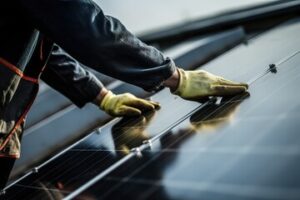Palm Beach Landscaping is an artistic and technical process that marries the home with its natural environment. It involves design planning, terrain assessment, and the integration of structural elements like patios, walkways, and retaining walls.
The first step is to remove all the distractions, like garden tchotchkes, wind spinners, gnomes, fountains, and other ornaments. Then you can begin to see your landscape as others will see it.
Plants have a big impact on landscape design. They add color, texture, and beauty to the overall space. They also help to control the microclimate of your yard, creating a more comfortable environment. For example, planting trees can create passive shading, reducing the ambient temperature by absorbing and reflecting light. Additionally, vegetation such as bushes and shrubs can serve as privacy screens, blocking sightlines into adjacent yards.
Using native plants is another way to reduce maintenance costs and environmental impacts. Native plants have evolved to thrive in your local climate and can withstand drought, freezing temperatures, and heavy rainfall. Additionally, they often require less watering, pruning, and oil-based lawn treatments than non-native species.
In addition, incorporating edibles into your landscaping is a great way to support local wildlife and add food to your household. Many native plants are fruit or nut producing and can be used to produce a vegetable garden or herb bed.
Plants are the foundation of any landscape. They dictate the shape, size, and structure of the rest of the landscape. Incorporating indigenous plants can greatly improve the health of the soil, and it is always a good idea to perform a soil test prior to any planting project.
Whether you are looking for a formal garden with straight lines, symmetrical flower beds, and manicured shrubs or an informal garden that follows the terrain with curved lines and a variety of blooming plants, we can help.
Studies have shown that homes with well-landscaped yards sell more quickly and at higher prices than similarly priced homes without beautiful landscaping. According to one study, a professionally designed landscape increases home value by an average of $20 for every dollar invested in it.
Hardscapes
Hardscapes are the non-living parts of landscape design. They include concrete, brick, stone and other manmade materials used to create functional outdoor spaces. Often, they contrast with the elements of nature that make up softscape.
The right hardscape designs can add to the beauty of your yard. For instance, using a variety of colors and textures in your paving materials can provide visual interest to any area of the garden. In addition to adding to the aesthetic of your landscape, these materials can also help reduce maintenance. For example, using pavers on a pathway rather than a traditional lawn minimizes the wear and tear to your yard.
Retaining walls are another common hardscape element in landscape design. These structural features are important for stabilizing sloped land and preventing soil erosion. They are also attractive when built in a garden with flower beds, shrubbery and trees.
For some homeowners, a mix of both hardscape and softscape landscape designs is best. This allows them to get the most use out of their yard. They can plant flowers, shrubs and trees to create a beautiful, natural setting while also adding in hardscapes like walkways, patios, driveways and water features for a balanced look.
Depending on your needs and preferences, choosing the right hardscape elements can transform your yard into a breathtaking sanctuary that is perfect for entertaining guests or relaxing with family and friends. With the right planning and professional installation, you can ensure that your landscape design is a harmonious balance of form and function. Contact us today to learn more about our landscape services and how we can help you create a beautiful backyard oasis!
Lighting
Effective lighting can draw attention to the focal points of your landscape. This includes things like beautiful trees, water features, and the architectural elements of your home. Lighting highlights these features and makes them stand out even after the sun goes down. It can also create dramatic shadow effects that add depth to your outdoor space. Our team is skilled at choosing the right fixtures and positioning them to highlight your outdoor features effectively.
Landscape lighting enhances the beauty of your home and extends its usability. It can highlight important pathways and make it safer to navigate your garden at night. It can also be used to create a mood or set the tone for evening gatherings. A well-designed outdoor lighting plan can improve the appearance of your home and increase its value at resale.
There are a few different types of landscape lighting to choose from, including path lights, downlights, and accent lights. Path lights illuminate walkways and highlight architectural features and plants. Downlights are installed overhead and cast light downward to mimic natural moonlight. Accent lights are used to highlight items in your landscape, such as fountains and statues.
When selecting your lighting, look for energy-efficient options to reduce electricity use and maintenance costs. Also, consider the environment by opting for eco-friendly solar-powered landscape lights. These lights harness the sun’s energy to provide illumination at night without consuming electricity, reducing your carbon footprint and making your home more sustainable for future buyers.
Irrigation
Landscapes require regulated amounts of water to support plant growth and encourage photosynthesis. But simply dragging out a garden hose and spraying down a lawn or shrubbery is not an efficient way to water.
Moreover, the quantity and quality of water used for irrigation affects overall landscape costs. Landscape professionals help property owners choose drought-tolerant plants and install efficient irrigation systems to minimize water use.
Water conservation strategies also reduce maintenance and repair costs. For example, mulches retain soil moisture and suppress weeds, which reduces the need for mowing, fertilizer, and edging. Water-efficient sprinklers and drip irrigation systems deliver water directly to roots, reducing evaporation. Irrigation controllers offer practical features such as rain delay to avoid overwatering during rainfall and a cycle soak that ensures water penetrates the soil deeply for effective root nourishment.
Landscape design also includes enhancing the quality of outdoor living spaces with water features like ponds, streams, waterfalls, and fountains. These elements add beauty, tranquility, and movement to the landscape and complement the architecture of your home.
The type of vegetation in your yard, the amount of sun or shade it receives, the size and slope of your land, and other factors influence watering needs. To conserve water, landscapers use hydrozones to irrigate groups of plants with similar watering needs. This method prevents high- and low-water-use plants from competing for water with each other, and it reduces waste. In addition, turf requires more water than other types of ground cover, so homeowners can save even more water by replacing it with a water-thrifty shrub or grass.
Xeriscaping
As a sustainable landscape practice, xeriscaping helps conserve water and reduce the use of resources that harm the environment. Xeriscape is most popular in the Southwest, but its principles can be applied anywhere. By replacing lawns with low-water trees, shrubs, and ground covers, xeriscaping provides beauty while reducing water usage, energy costs for watering, and the need for chemical fertilizers and pesticides. It also promotes biodiversity and provides wildlife habitat.
Xeriscape designs often feature native plants that are naturally drought-resistant and thrive in the climate of their region. These include deciduous and evergreen trees, shrubs, perennials, and ground covers like sage, sedum, yarrow, and juniper. When properly planned and maintained, a xeriscape can be beautiful, easy to care for, and provide food and shelter to local birds, insects, and wildlife.
The xeriscape approach also benefits the environment by preserving water quality in rivers, lakes, and aquifers for drinking, recreation, and agricultural uses. Less water used for lawns and more water available for crops will help reduce stress on local water sources, which are being stretched thin in many areas because of population growth and climate change.
Besides prioritizing water conservation, xeriscape design includes a soil test to determine the best growing conditions for your yard. Properly amended soil is key to a healthy, vibrant xeriscape. Mulching is a key maintenance element of xeriscaping because it provides a more pleasing visual appearance, locks in moisture that would otherwise evaporate quickly, maintains cooler soil temperatures, lessens soil erosion from wind and rain, and prevents the germination of weeds. Other maintenance includes regularly pruning trees, shrubs, and perennials; weeding; and refreshing mulch. Some cities and counties offer rebates or other financial incentives for homeowners who replace grass with xeriscape.







 Cracks
Cracks
